Agile management has become an essential part of any modern business looking to improve efficiency and effectiveness. The key to carrying out a successful Agile implementation is to have a well-organized and structured product backlog. In this article, we will provide some clear and useful examples of a product backlog, along with effective strategies to manage and improve your Agile processes.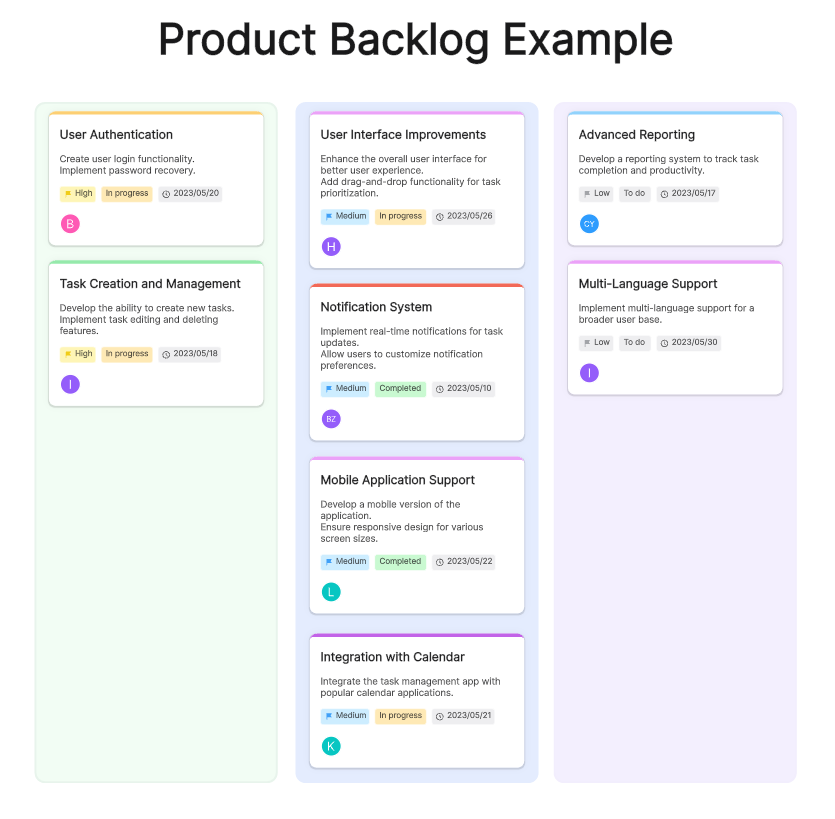
What is Product Backlog?
A product backlog is an ordered list of everything that is necessary for the product and is known to be needed at some point. Basically, it is a list of features, functions, improvements, changes, and fixes that need to be made to a product during its lifecycle.
The product owner is responsible for maintaining the product backlog, prioritizing features and requirements based on business value and product strategy. The product backlog should be transparent and visible to all team members and stakeholders.
Key Features of a Product Backlog
- User stories and acceptance criteria: Each backlog item is framed by a user story with clear acceptance criteria. This ensures that the team understands the user's perspective and can validate the completion of each item.
- Estimates: Although not required, many teams assign rough estimates (story points, for example) to backlog items. This helps in sprint planning and resource allocation.
- Dependencies and relationships: The backlog can highlight dependencies between items, helping the team understand the order in which features should be developed. It also allows for identifying potential bottlenecks.
- Backlog grooming: Regular backlog grooming sessions, often conducted during sprint planning or separately, ensure that the backlog remains relevant, well-prioritized, and aligned with project goals.
- Ready for sprint planning: Items at the top of the backlog are considered “ready for development” and are considered candidates for inclusion in the next sprint. The team, guided by the product owner, selects items based on their priority and capacity.
Benefits of Effective Product Backlog Management
- Improved communication: A well-maintained backlog serves as a central point of reference for the entire team. It fosters communication and alignment by providing a shared understanding of project priorities.
- Flexibility and adaptability: The dynamic nature of the product backlog allows teams to quickly adapt to changing requirements and market conditions. New features can be introduced and existing features reorganized based on new needs.
- Increased transparency: Stakeholders, including development teams, product owners, and external contributors, benefit from a transparent and accessible backlog. This transparency helps build trust and collaboration.
- Customer satisfaction: By focusing on the highest priority items first, teams can deliver value to end users sooner, increasing customer satisfaction. This iterative approach allows for continuous improvement based on user feedback.
Comparison: Product Backlog vs Scrum Product Backlog vs Agile Scrum Product Backlog
The terms Product Backlog, Scrum Product Backlog, and Agile Scrum Product Backlog are closely related but have slight distinctions based on their context and framework.
Product Backlog

- Definition:
A prioritized list of tasks, features, fixes, and technical needs that outlines all work required for a product.
- Framework:
Broadly used in various Agile methodologies, including Scrum, Kanban, and SAFe.
- Purpose:
To provide a roadmap of everything that contributes to the product's development.
- Ownership:
Managed by the Product Owner or a similar role, depending on the framework.
- Examples of Use:
Found in Agile projects that don't strictly follow Scrum practices.
Scrum Product Backlog
- Definition:
A specific implementation of a product backlog tailored to the Scrum framework. It serves as the single source of truth for all work planned for the product within Scrum teams.
- Framework:
Exclusively used in Scrum, structured to support iterative sprint planning.
- Purpose:
To guide Scrum teams by aligning sprint goals with the overall product vision.
- Ownership:
Always owned and managed by the Scrum Product Owner, refined collaboratively with the Scrum Team.
- Examples of Use:
Includes sprint-ready user stories, prioritized based on business value, and aligned with the sprint backlog.
Agile Scrum Product Backlog
- Definition:
Combines the broader Agile principles with the structured approach of the Scrum framework. Essentially, this is another way to describe the Scrum Product Backlog, emphasizing its role in Agile practices.
- Framework:
Focused on Agile principles but implemented specifically within Scrum.
- Purpose:
To highlight how Scrum-specific backlogs align with Agile's iterative and incremental delivery philosophy.
- Ownership:
Managed by the Product Owner, but it underscores Agile values like adaptability and customer collaboration.
- Examples of Use:
Often used in discussions where Agile and Scrum practices are blended or compared.
Key Differences
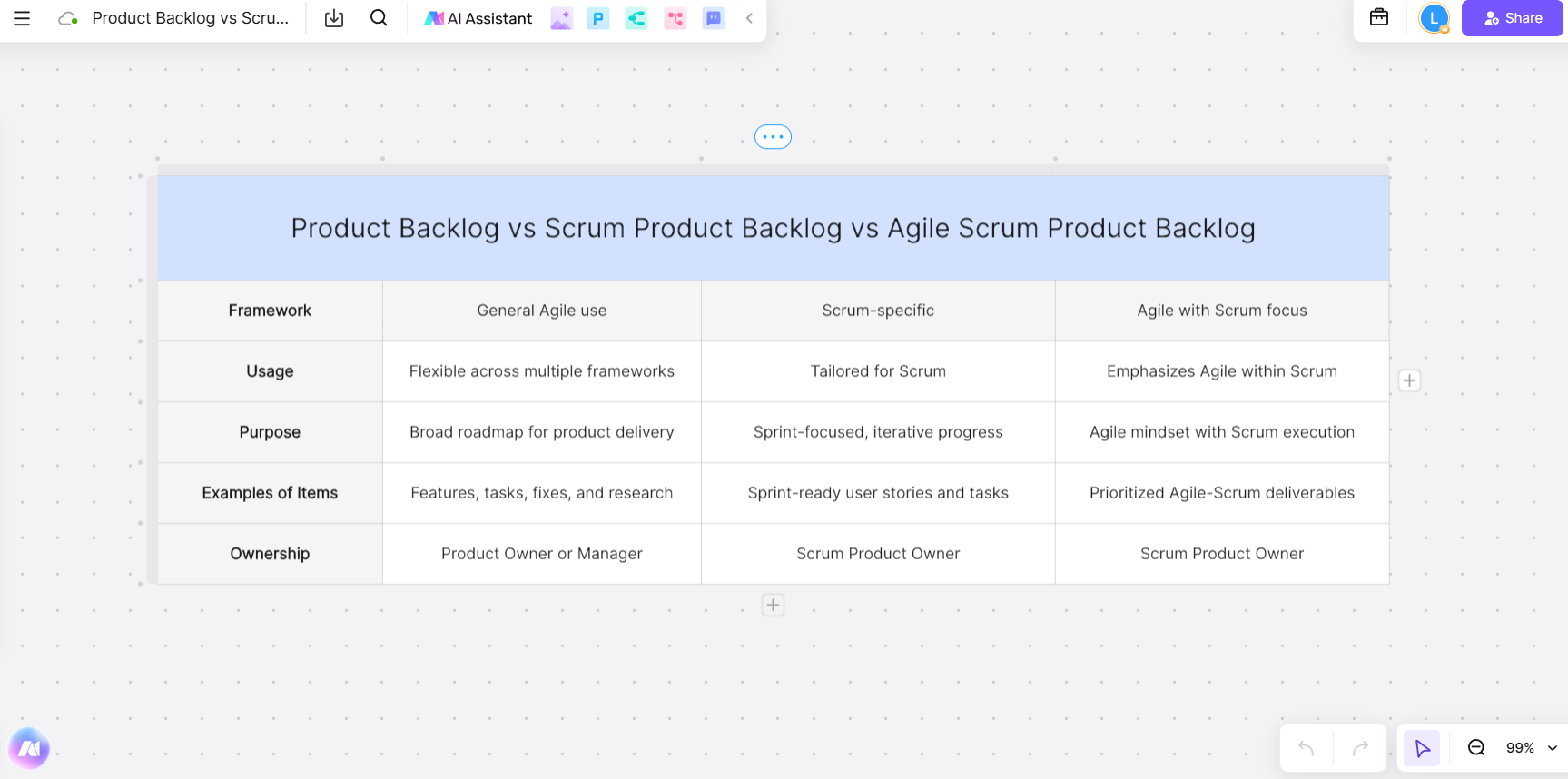
Comparison Summary
- Product Backlog applies across Agile frameworks.
2)Scrum Product Backlog narrows its focus to Scrum-specific implementations.
3)Agile Scrum Product Backlog emphasizes the synergy between Agile principles and Scrum practices.
In practical terms, all these terms describe variations of the same concept, adapted to different frameworks or perspectives.
Learn about Examples of Product Backlog
To better understand what a product backlog looks like in action, here is a detailed example of what a product backlog for a food delivery mobile app might look like as follow.
Food Delivery Product Backlog Example
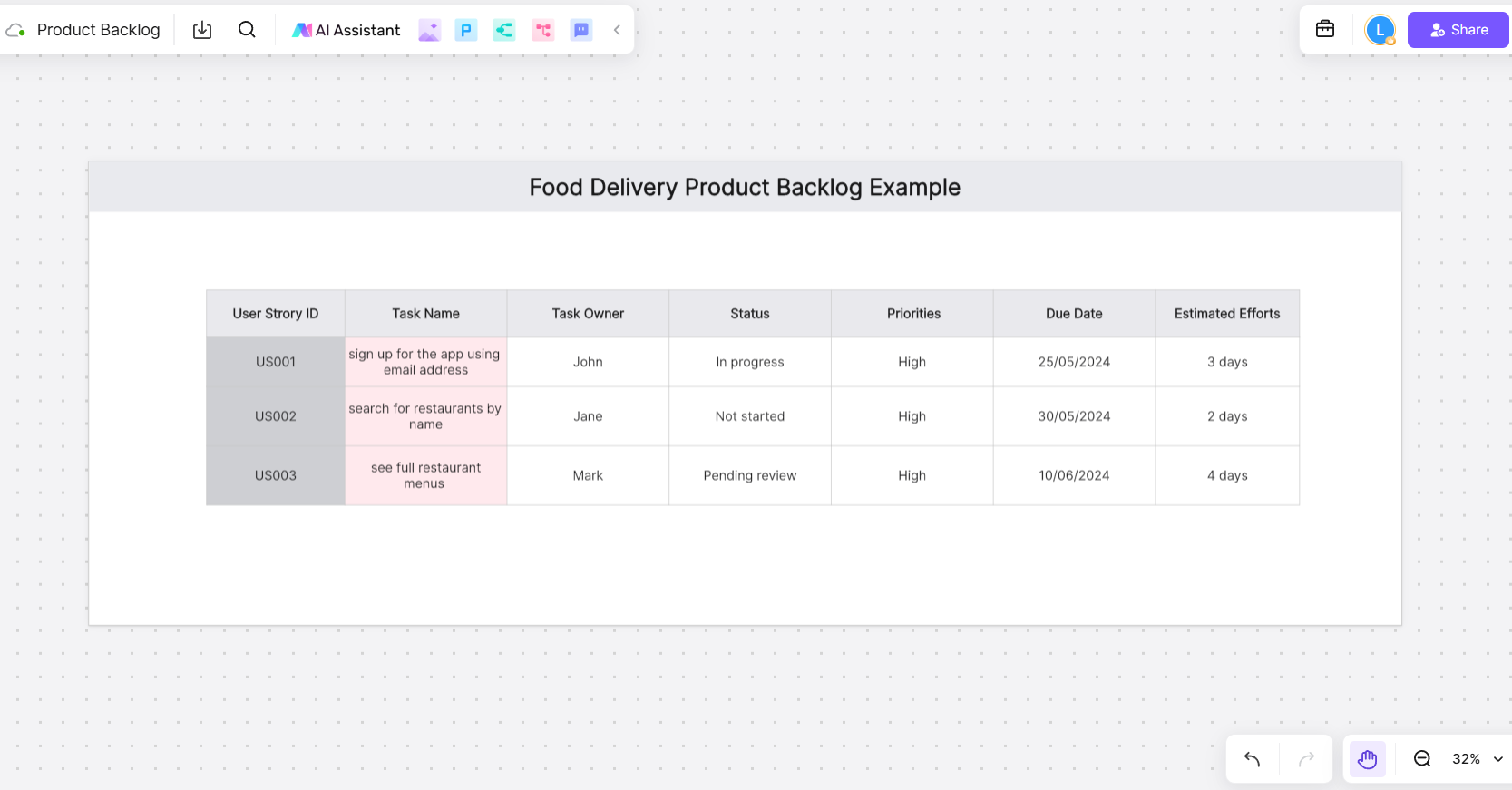
User Story 1: As a user, I want to be able to sign up for the app using my email address so I can place orders.
Priority: High
Effort estimate: 3 days
User Story 2: As a user, I want to be able to search for restaurants by name to quickly find my favorites.
Priority: High
Effort estimate: 2 days
User Story 3: As a user, I want to see full restaurant menus so I can select what I want to order.
Priority: High
Effort estimate: 4 days
User Story 4: As a user, I want to add items to my cart so I can place an order.
Priority: High
Effort Estimate: 2 days
User Story 5: As a user, I want to be able to pay with a credit card to complete my order.
Priority: High
Effort Estimate: 5 days
User Story 6: As a user, I want to receive notifications about the status of my order so I know when it will arrive.
Priority: Medium
Effort Estimate: 3 days
User Story 7: As a restaurant manager, I want to be able to update the menu in real time so users always see the current options.
Priority: Medium
Effort Estimate: 4 days
User Story 8: As a restaurant manager, I want to see a daily summary of orders placed to keep track of the business.
Priority: Low
Effort Estimate: 3 days
Example of a Scrum Product Backlog
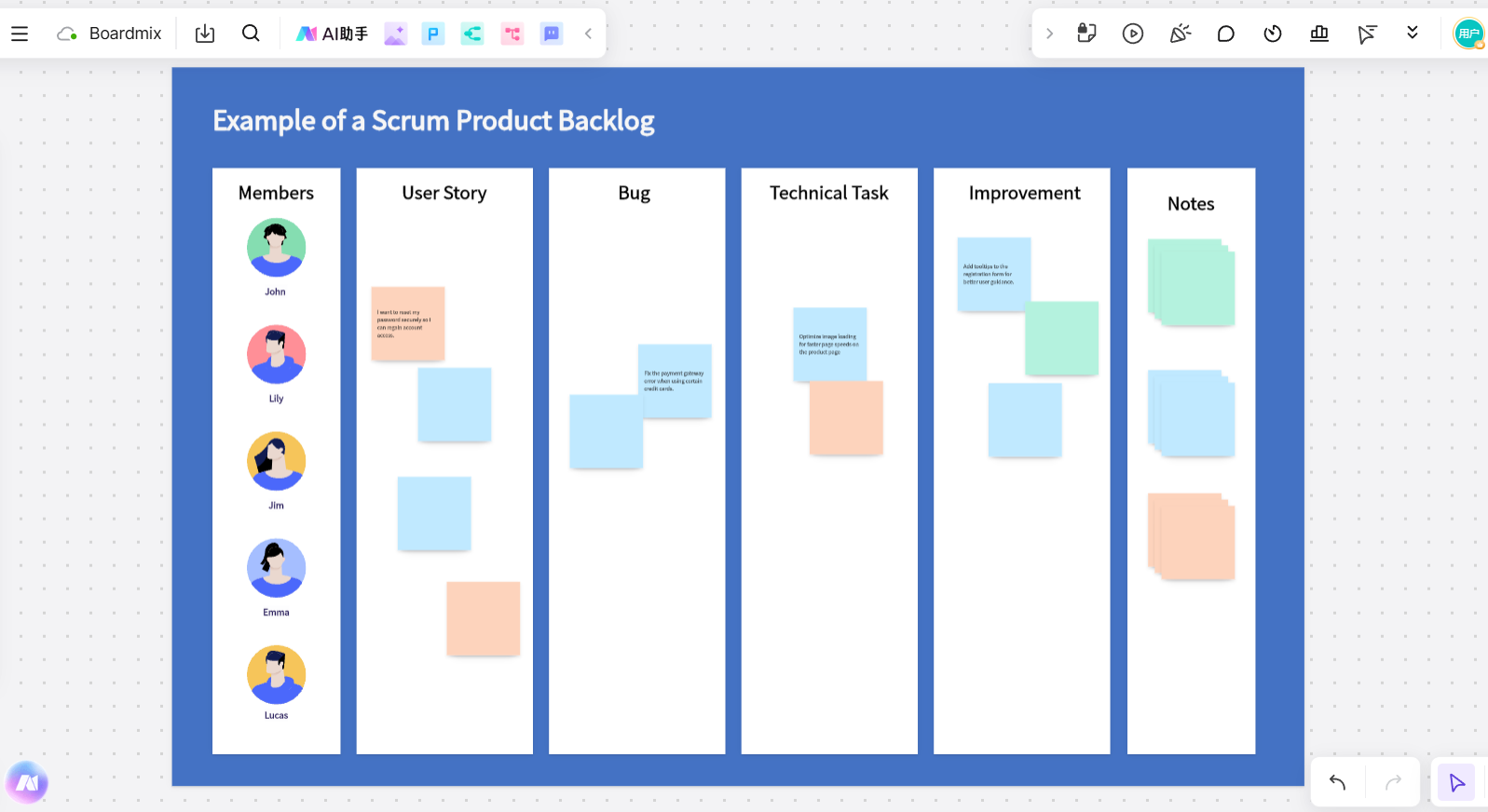
A Scrum product backlog is a prioritized list of deliverables broken into small, actionable tasks for the development team. Each item is referred to as a backlog item or user story. For example:
- User Story: "As a customer, I want to reset my password securely so I can regain account access."
Acceptance Criteria:
Password reset link must expire after 24 hours.
Include a CAPTCHA for security.
- Bug: "Fix the payment gateway error when using certain credit cards."
- Technical Task: "Optimize image loading for faster page speeds on the product page."
- Improvement: "Add tooltips to the registration form for better user guidance."
Case: A team developing an e-commerce platform may have a Scrum product backlog that includes user stories for new features like "product recommendations" alongside bugs such as "search bar glitch" and technical tasks like "database indexing."
Example of an Agile Product Backlog
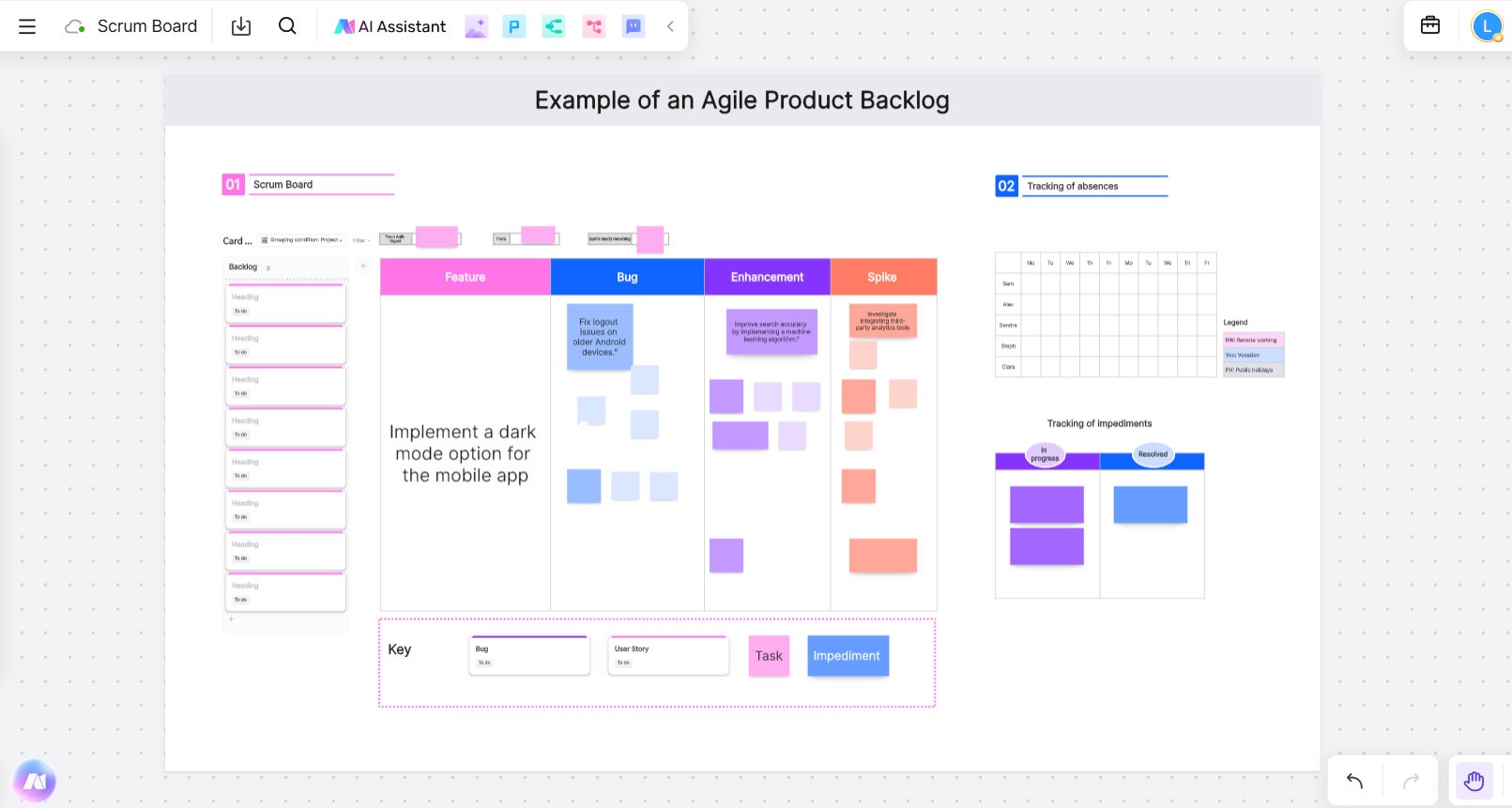
An Agile product backlog follows a similar structure but may span broader Agile frameworks. It serves as a living document that accommodates continuous feedback and evolving priorities. For instance:
- Feature: "Implement a dark mode option for the mobile app."
Subtasks: Research, design mockups, code implementation, and user testing.
- Bug: "Fix logout issues on older Android devices."
- Enhancement: "Improve search accuracy by implementing a machine learning algorithm."
- Spike (Research Task): "Investigate integrating third-party analytics tools."
Case: A fintech app team may maintain an Agile product backlog where customer feedback like "add recurring payment reminders" is quickly added and prioritized alongside technical work like "updating security protocols." This approach ensures the product evolves to meet user and business needs dynamically.
Use Free Product Backlog Templates
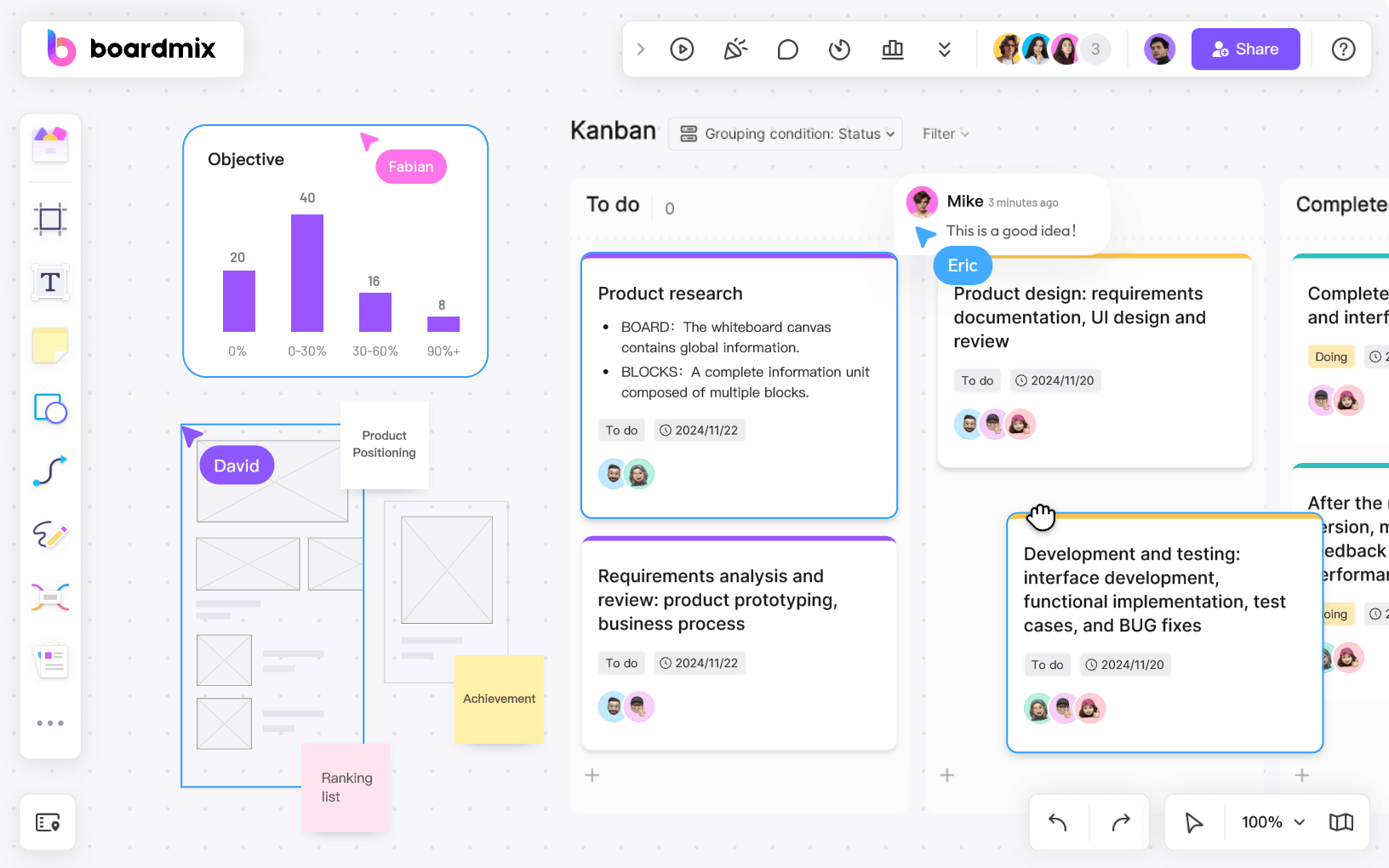
Boardmix is a revolutionary online whiteboard tool that simplifies the product backlog creation process. With our wide range of pre-designed templates, you can easily visualize and organize your product backlog in a clear and concise way. Boardmix allows you to prioritize tasks, track progress, and collaborate with team members in real-time. If you are a product manager, software developer, or part of an agile team, Boardmix's intuitive interface and powerful features make managing your product backlog easier than ever.
How to use the product backlog template in Boardmix:
- Log in to your Boardmix account and go to the "Templates" section.
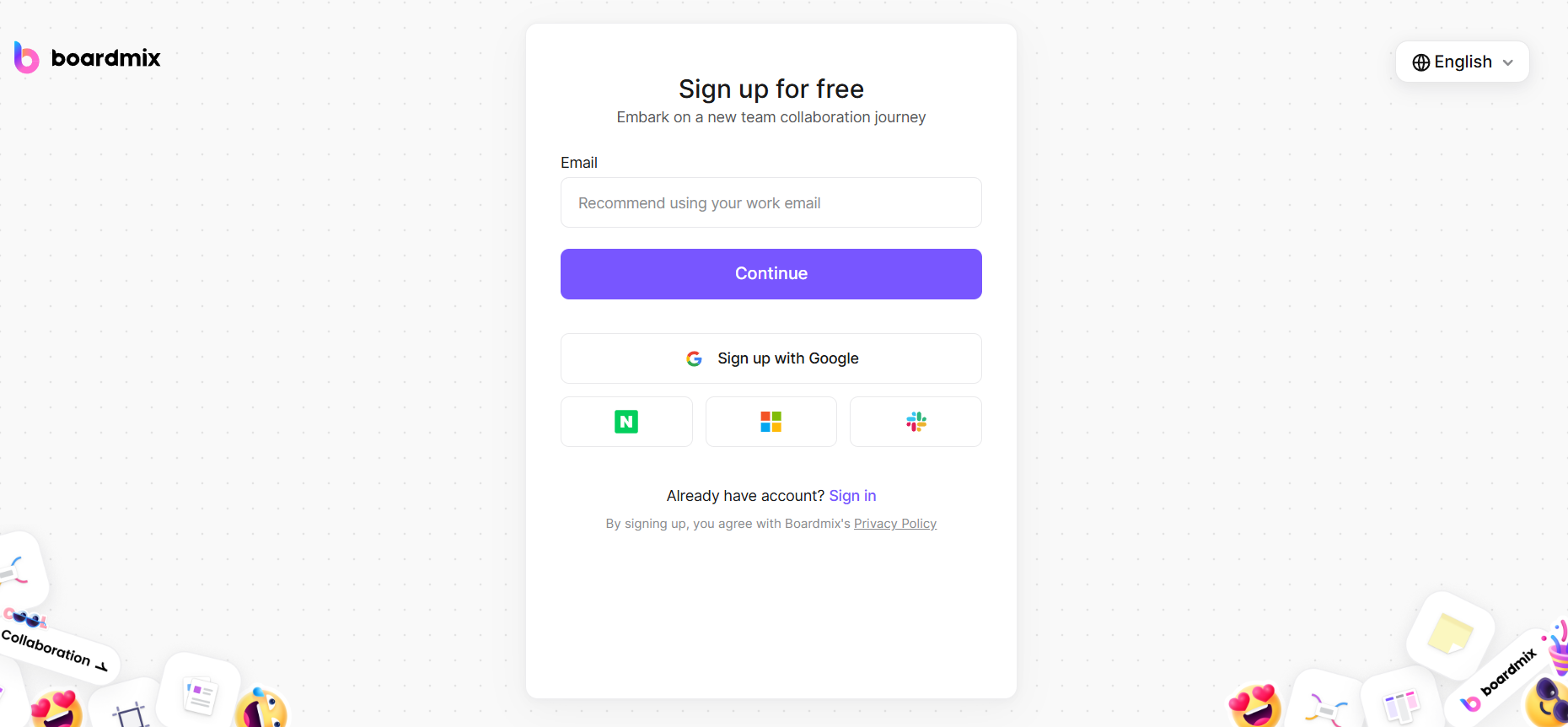
- Search for the 'Product backlog' template in the search bar or browse our collection of templates.
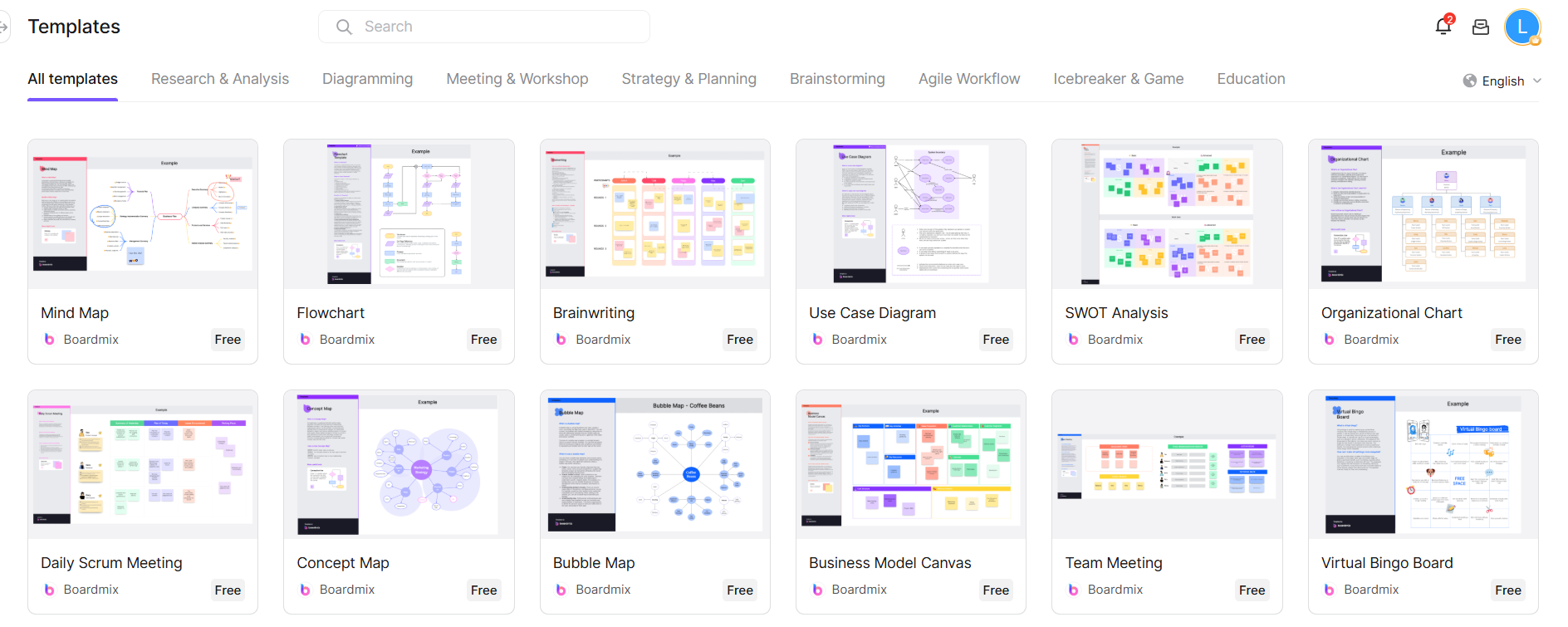
- Once you have found the template, click "Use" to open it.
- You will now see a pre-structured board with different sections such as "To Do", "In Progress" and "Done". You can customize these sections to suit your project needs.
- Start adding tasks or items to your backlog by clicking the "+" button or simply dragging and dropping them into the appropriate sections.
- Assign priorities, deadlines, and team members to each task for better organization and tracking.
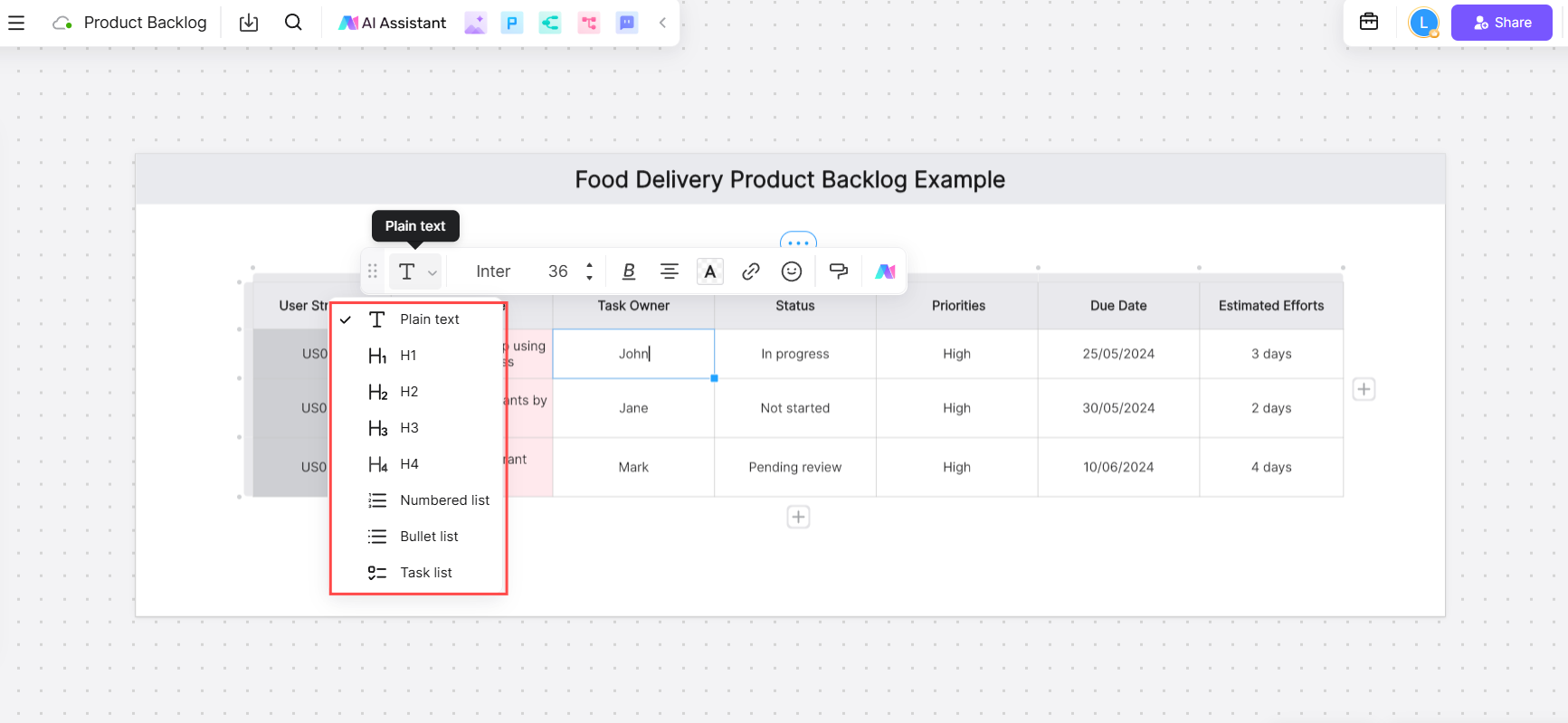
How to Improve Agile Management with an Effective Product Backlog?
- Regular prioritization
Regularly prioritizing product backlog items ensures that the most pressing and valuable needs of the product are being addressed. Criteria for prioritization can include business value, urgency, dependency, and risk.
- Continuous Refinement
The product backlog should be constantly reviewed and refined to ensure its relevance. New items can be added while obsolete or irrelevant items can be removed or discarded.
- Clear and Concise
Product backlog items should be clear and concise. Each user story should be small enough to be completed in a sprint, but large enough to deliver value to the end user.
FAQ about Product Backlog
What is a product backlog in scrum?
In Scrum, the product backlog is a prioritized list of tasks, features, improvements, and fixes required to deliver a product. Managed by the Product Owner, it serves as the single source of work for the Scrum team, evolving throughout the project as new requirements are identified or priorities change.
What is a product backlog in agile?
A Product Backlog in Agile is a dynamic, prioritized list of all the work required to deliver a successful product. It includes features, enhancements, bug fixes, and other tasks that contribute to achieving the product goals. The backlog evolves as the project progresses, with items added, removed, or reprioritized based on feedback and changing requirements.
Who owns the product backlog?
The Product Owner owns the product backlog. They are responsible for ensuring it is well-organized, up-to-date, and aligned with the project goals.
Who is accountable for ordering the product backlog?
The Product Owner is accountable for ordering the product backlog. They prioritize items based on business value, stakeholder input, and team feedback to ensure maximum impact.
Who makes the final decision on ordering the product backlog?
The Product Owner makes the final decision on the ordering of the product backlog. While they consider input from stakeholders and the development team, the ultimate responsibility lies with them to balance priorities and deliver value effectively.
Conclusion
In conclusion, a well-managed product backlog is essential to successful Agile development. It provides clarity, transparency, and a roadmap for the development team, allowing them to deliver value iteratively. Using the example of a task management application and exploring the different facets of backlog management, we have gained insight into its dynamic and adaptable nature.
Experience a new level of efficiency in managing your product backlog with Boardmix. Our intuitive online whiteboard tool, packed with pre-designed templates, lets you prioritize tasks, track progress, and collaborate in real-time. Join Boardmix today and transform the way you manage your product backlog.









